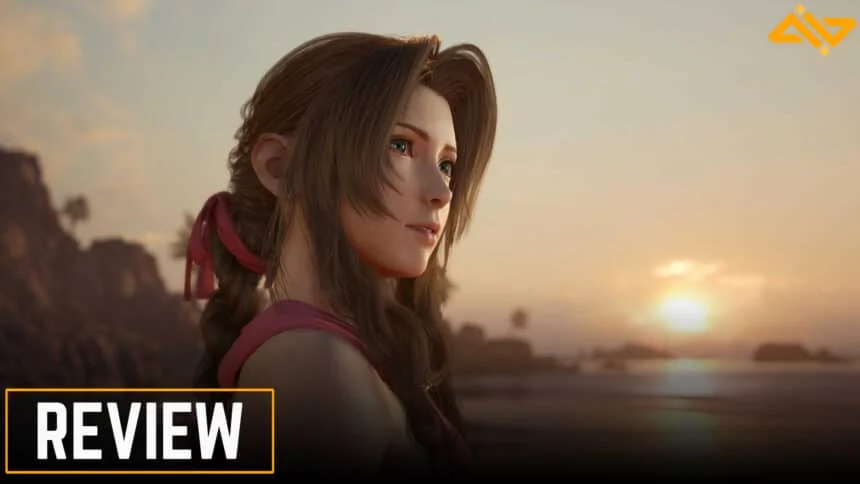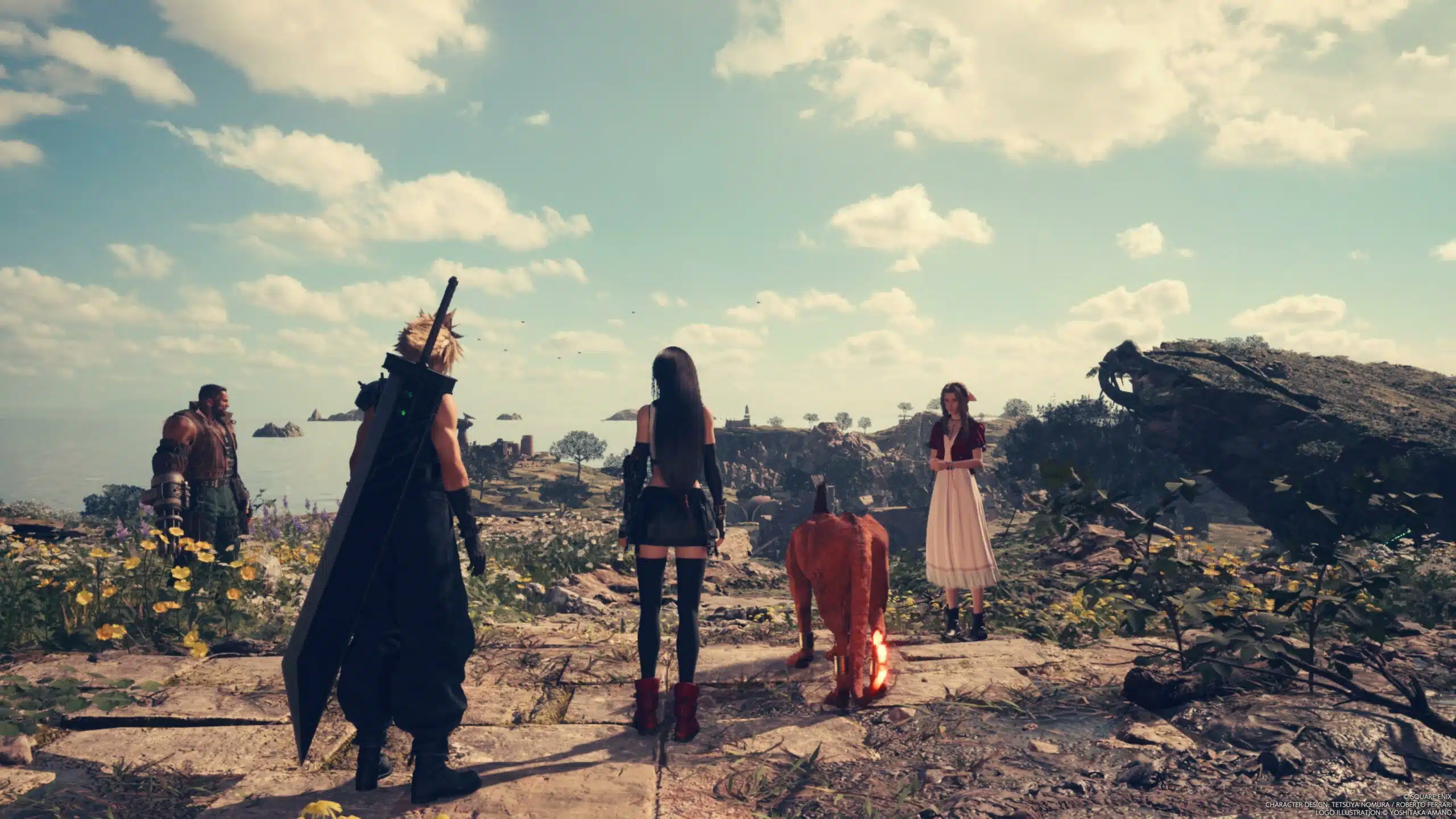Having never played the Original FF VII, I was exposed to its gripping story and colorful cast of characters through the 2020 Remake and immediately fell in love with it. And so, I went into the second installment with some mighty high expectations and I’m happy to report that the game manages to smash right through them. In my Final Fantasy VII Rebirth review, I’ll discuss how its memorable characters, improved combat mechanics, and eye candy-filled semi-open world presentation make it a standout JRPG and a worthy sequel.
The Unknown Adventure Continues

Rebirth starts right where the Remake left off and immediately sets the tone for the rest of the game as the gang deals with their traumatic pasts, and their relationships with each other get a bit testy as well. Cloud still keeps seeing Sephiroth as he sows seeds of doubt in his mind about Tifa and her existence.
The gang and Cloud have just escaped Midgar and must follow the black-robed men to try and locate Sephiroth. The pool of playable characters grows significantly this time as Yufie, Red XIII, and Cait Sith join the party.

I won’t be covering every detail of the story as that’ll ruin the experience for you, but expect the same kind of melodrama you saw in the first part. Each playable character has a relationship bar that appears on their heads (ranging from a grey frown to a blue smiley face). Their relationship deepens with Cloud depending on how many side quests you do with them and your dialogue choices at key moments.
The plot and character interactions are, in my opinion, one of the strongest suits of this game. Each time you see Aeirth on screen, you can notice her usual warm-hearted personality but a slight hint of worry or, should I say, sadness. This is true for every other character as well. It makes you feel everyone is worried about the future while simultaneously trying to uplift the team’s mood.
Shifting Towards a Semi-Open World

Final Fantasy VII Rebirth divides the original’s overworld into 6 open-world regions. The party starts with the Grasslands in Chapter 2 and then works its way through the other regions. Each region has a distinct aesthetic and looks beautiful. Open fields, Shinra bases, mountains, forests, deserts, and oceans, you’ll get everything here. The sense of mystery and discovery that the franchise is famous for is still there.
Rebirth packs its massive regions with dozens of activities to complete. You’ll meet Chadley quite early on in the Grasslands, and he will bring you up to speed with how exploration and intel gathering work in the game. You can explore the map to uncover lifesprings, Excavation sites, towers, combat challenges, and other activities. He will use these points to craft new/better materia and summon crystals for you.

I initially worried about the open world being too dull or the activities feeling like a chore. That isn’t the case, as exploration has a clear purpose of unlocking/upgrading materia and thus feels even more rewarding.
You can’t play the game at a higher difficulty level without properly equipping each character with suitable materia and team compositions. More on that later in the combat section.
Moving Around the Regions

As we’ll be making our way through massive regions, it is only natural that the game provides means of transportation and fast travel points. You’ll get a fast travel point at every point of interest on the map and be able to use Chocobos to move around within each region.
You’ll catch these birdies by progressing the story, completing a certain side quest, or going through a sneaking minigame, which requires you to get close to a Chocobo and catch it. Each region has its own Chocobo with its unique properties.
For example, the Chocobo in the Junon region can climb walls, and the one you get in the Gongaga region can bounce off of mushrooms. The game encourages you to get each region’s Chocobo ASAP by placing POIs and sidequests in areas that can only be reached by using the Chocobo’s special ability.
And it’s not just Chocobos, either. You’ll be able to ride buggies and electric scooters in certain regions of the game. Exciting stuff.
Quests

The main quests are exactly what you’d expect from the game. You and your party will push through the different regions of the game while solving puzzles and taking on monsters, Shinra Turks, and other baddies alike. It is very action-heavy and filled with detailed cutscenes.
Since the game has roughly 5-6 characters at all times, you’ll often be divided into teams of two and complete parts of the quest alone, while the other half of the party focuses on some other objective. I found this to be the perfect way to balance the time you get to spend with each character and interact with them.

If you look towards the 4-to 5 side quests in each region, you’ll be able to build your relationship with each playable character in the game through these side quests. Your relationship’s state will determine who will date you once you reach the Golden Saucer in Chapter 8.
These side quests are varied and interesting enough to keep you hooked. You’ll find lost materials, turn into a toad, defeat tough side bosses, learn how to play Queen’s Blood (the new card game introduced in Rebirth), and even unlock the region’s Chocobo through them.
Completing these side quests will ensure that your character, weapons, and party are always adequately leveled for the next main quest. So, DON’T SKIP THESE!
Minigames

And the minigames….. There are more than 15 minigames in Final Fantasy VII Rebirth, and I’ve sunk a questionable number of hours into each of them. A lot of the minigames are returning from the OG game and there are a few new additions as well, such as Queen’s Blood (the card game).
I didn’t expect it to be this addictive. It is not a very technical game but has enough depth to keep you busy for a good while. You get to fight players in each region of the game. Buy or acquire cards by defeating players and build the ultimate Queen’s Blood deck.
The vast majority of the minigames can be found at the Golden Saucer, where you’ll go during Chapter 8 of FF VII Rebirth. I suggest you thoroughly explore the Golden Saucer and try your hand at all the different minigames there. Did I mention that there’s Chocobo racing in there as well?
The Combat

The combat system is the crown of Final Fantasy VII Rebirth and one of its strongest features. It was already great in the 2020 Remake, and Square Enix has made it even better by doubling down on the Pressure/Stagger mechanics and improving the overall free-flow fighting style.
Each character can be built around offense, defense, or being a support. You get to choose the weapon, armor pieces, and materia setup for each playable character (just like the previous game).
If it becomes too much of a hassle for you to manage all of the characters at once (like it did for me at one point), you can set their upgrade trajectory based on how you want to build them and let the game do it for you automatically. I consider myself to be a hassle-hating person who gets annoyed by convoluted and confusing mechanics. This is the perfect answer for people like me.
Synergies Make a Return
Remember the Synergy Abilities introduced in the Intergrade DLC? Well, they are a big part of Rebirth and add a new layer of depth to the combat. Each character in your party can perform special moves by pairing up with other characters and filling a required number of little ATB bars.
These attacks deal increased damage to staggered enemies and often provide other bonuses such as unlimited MP for a limited time, etc. Using Synergy Abilities also builds your relationship with that character. Since I mostly play with the Cloud – Tifa – Aerith team composition, my relationship with both the girlies was in the blue by the time I got to Chapter 8.
Pressing the R1 button lets you use another version of Synergy Abilities that can be used without having to fill the blue bars. Cloud can use this ability to counter incoming attacks with the help of another teammate. Tifa can ask others to launch her in the air and target airborne enemies.
Cloud has seen some major improvements to his moveset. My favorite change is the ranged slash attack, which lets Cloud deal damage to airborne enemies and fight them without needing Barret on his team. Tifa, Aerith, and Barret play mostly the same.
Red XII, Yuffie, and Cait Sith bring their playstyles, strengths & weaknesses to the team, and you’ll have fun getting used to their movesets. Yuffie is by far the deadliest edition to the team since she can deal tons of ranged, and close-quarter damage. Build an offensive Yuffie that excels at dealing fire damage and see how she shreds through mobs with Cloud’s support.
Soundtrack | Aesthetics
Final Fantasy VII Rebirth considers its soundtrack a character as well and wants the players to listen to whatever is going on with it at all times. I noticed how the soundtrack was very loud and often overlapped everything else while I was exploring & especially during combat.
I’ve shared a clip of me exploring the coastal areas of Junon. Notice how the intriguing exploration music shifts to a completely different and mysterious tone as soon as I get close to a Lifespring. Masashi Hamauzu and Mitsuto Suzuki are aces of their work and know how to set the mood with a masterfully crafted soundtrack.

Every region in the game carries a distinct aesthetic and no two areas feel the same. This, in my opinion, is an accomplishment these days when it is very easy to get lost in the “copy-pasting same assets throughout the map” trap just to add more square kilometers to the game’s map.
I noticed how much attention they’ve put into making the Gold Saucer a ridiculously large and believable arcade with its vibrant color pallets and welcoming soundtrack.
Considering how dull and depressing the area before the Golden Saucer was, arriving on the saucer and exploring its different areas made me smile. Rebirth succeeds in making sure that all 6 of its regions feel different and raises the player’s curiosity to encourage exploration.
Performance

My only major gripe with the game is its lighting and performance mode inconsistencies. Rebirth sometimes lacks basic lighting and shadows indoors, as seen in the screen capture above. The lighting can get worse than it was in the PS5 version of FF VII Intergrade. This was most prominent in the Junon region, especially during the parade section.
The other issue is with the game’s performance mode. While it maintains 60 frames or stays in the 50s, the image quality you get in return is really bad. The average downscaled resolution remains around 1080p, but the game upscales it back to 4k in a weird way, which causes blocky & blurry visuals.
I tried playing in Performance mode till the start of Chapter 3 but then shifted to Graphics mode as the extra frames were not worth looking at blocky visuals when the world looks as beautiful as it does in Rebirth. These problems are not game-breakers but can easily be fixed in future updates.
Fast traveling around the map usually takes around 4-5 seconds, thanks to the PS5’s Gen4 NVMe. So, getting around the map quickly is never a pain.
Closing Thoughts

I’ll wrap this review by saying that Square Enix is delivering on their promise to reimagine this legendary game as a modern-day classic and steer the franchise in a new direction. It is better than what any of us could have imagined.
The fast-paced combat, fantastic story-telling, memorable characters, well-crafted open regions, and the sheer amount of (meaningful) content on offer here are well worth the 70$ price tag.
This grand adventure will take you anywhere between 45-80 hours to complete based on how much side content you cover and the amount of time you are willing to spend playing minigames. Not a second of it felt boring, and I eagerly await the trilogy’s third part. The unknown adventure shall continue once again!
This review is based on the PS5 version of Final Fantasy VII Rebirth. The key was provided by Square Enix.











